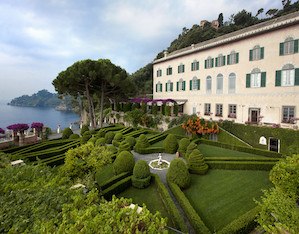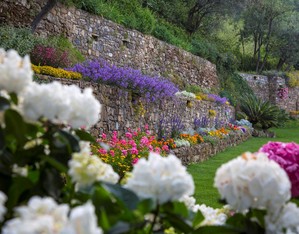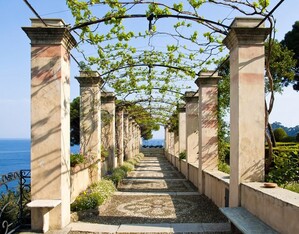What was once the monk’s old vegetable garden today is an extraordinary example of Italian formal garden nested in a unique setting: with its two-level skilfully orchestrated layout, this garden offers multiple views Gulf of Tigullio alternating belvedere terraces, pergolas laden with flowers, and more intimate corners.
The abbey complex, built starting from 1361 by the Benedictine Ottone Lanfranco, reached its highpoint between the 15th and 16th centuries. With the Napoleonic suppression of monastic orders, Abbazia della Cervara fell into neglect and in 1859 it was annexed to the Diocese of Chiavari. Entrusted first to the Somascan and then to the Carthusian order, in 1937 it became a private residence. A careful restoration of the complex was undertaken in 1990. The garden is composed of various sectors making the most the property’s uneven land. The “monastic” garden is located in the 16th-century cloister while the “gardenia garden” framed by a pergola features the Fountain of the Dolphin at its centre; a slate slab belvedere-terrace and the “mandarin garden” are adjacent to the building. At a lower level is the Italian garden, enclosed by a vine pergola embellished by a geometric cobblestone flooring: quadrangular in shape it features a central octagonal water basin decorated with a 17th century putto. Divided into rectangular and lozenge compartments it is bordered by cleverly shaped boxwoods. A nymphaeum with a marble mascaron is set at the centre of the stairway leading to the upper terrace whose walls are entirely lined with Ficus pumila. The southern “Portofino garden” overlooks the coves of Paraggi and Portofino, while the “Giardino dei Semplici” and the terrace in the woods are laid out on the upper terraces.
Highlights

The monastic complex
The Cenobio della Cervara is a place of beauty and meditation with the exquisite church of San Girolamo and its crypt, the 15th-century Great Hall and the 16th-century cloister. The old Saracen tower where the king of France Francis I was confined after the battle of Pavia in 1525 is now a refined suite.

Botanical profusion
Walls lined with Ficus pumila and pink capers, citrus fruits, oleanders, Aleppo pines, and eucalyptus trees: fragrant Mediterranean vegetation coexisting with plants from all over the world, including specimens of false pepper tree, the American agave, the strelitzia, the Chinese palm, camellia and bougainvillea.

Pergola
A beautiful pergola overlooking the sea, covered with sweet-smelling star jasmine with a geometrically patterned cobblestones floor, is formed by a set of octagonal pillars connected by walls fitted with ardisia benches where visitors can enjoy the shade and the view.
 Abbazia della Cervara
Contacts
Abbazia della Cervara
Contacts
Contacts
Telephone:- +39 0185 293139
- +39 0185 293026 (visite)
Fax +39 0185 291270
Address
Lungomare Rossetti – via Cervara, 10
16038 , Santa Margherita Ligure (GE)
 Abbazia della Cervara
Opening times and prices
Abbazia della Cervara
Opening times and prices
Opening hours
March to October
- the first and third Sunday of the month (taking care to check the closing Sundays on the Calendar) at 10 am, 11 am and 12 am.
Groups
- With a minimum of thirty people and compulsory booking, the Abbey can be visited every day of the year, also in English, French, German and Spanish. It is also possible to follow the visit with an aperitif or a buffet lunch. Information and reservations at +39 0185 293026 or by e-mail.
Pricing
 Abbazia della Cervara
How to get there
Abbazia della Cervara
How to get there
Address
Lungomare Rossetti – via Cervara, 10
16038 , Santa Margherita Ligure (GE)
Latitude: 44.3135551
Longitude: 9.2107252
How to arrive by road
 Abbazia della Cervara
Services/Accessibility
Abbazia della Cervara
Services/Accessibility
Services
Alternative themed routes are also available on request:
- "From the Sylvaria to the Italian Garden": a historical botanical journey;
- "The monastic presence on Monte di Portofino": the historical cenobi and the events of the settlement, the characteristics of the Benedictine order and its artistic and architectural expressions;
- "The tapestries and the furnishings": a tour of the Piano Nobile, from which you can admire the Monumental Garden, even in case of inactivity due to bad weather.
For information and bookings guided tours call +39 0185 293026 or write to the garden email address.
You can stay in the rooms provided by the abbey. Information and reservations +39 0185 293139 or [email protected]
 Abbazia della Cervara
Private events
Abbazia della Cervara
Private events
At Abbazia di Cervara it is possible to organize anniversaries, private parties, gala evenings, musical afternoons, weddings, congresses, business meetings for small groups, theme days, business lunches and lunches, gala evenings.
 Abbazia della Cervara
Itineraries
Abbazia della Cervara
Itineraries
You could find the garden in these itineraries
 Favorite saving result
Favorite saving result
 Warning!
Warning!
You've have to sign up or sign in to add this element to your favorites.
